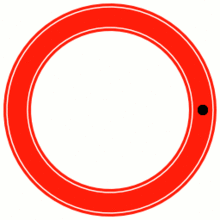Lonely runner conjecture

In number theory, and especially the study of diophantine approximation, the lonely runner conjecture is a conjecture originally due to J. M. Wills in 1967. Applications of the conjecture are widespread in mathematics; they include view obstruction problems[1] and calculating the chromatic number of distance graphs and circulant graphs.[2] The conjecture was given its picturesque name by L. Goddyn in 1998.[3]
The conjecture
Consider k runners on a circular track of unit length. At t = 0, all runners are at the same position and start to run; the runners' speeds are pairwise distinct. A runner is said to be lonely at time t if he is at a distance of at least 1/k from every other runner at time t. The lonely runner conjecture states that each runner is lonely at some time.
A convenient reformulation of the problem is to assume that the runners have integer speeds, not all divisible by the same prime; the runner to be lonely has zero speed. The conjecture then states that for any set D of k − 1 positive integers with gcd 1,
where ||x|| denotes the distance of real number x to the nearest integer.
Known results
| Can the Lonely runner conjecture be proved for k≥8? |
| k | year proved | proved by | notes |
|---|---|---|---|
| 1 | - | - | trivial: t = 0; any t |
| 2 | - | - | trivial: t = 1 / (2 * (v1-v0)) |
| 3 | - | - | Any proof for k>3 also proves k=3 |
| 4 | 1972 | Betke and Wills;[4] Cusick[5] | - |
| 5 | 1984 | Cusick and Pomerance;[6] Bienia et al.[3] | - |
| 6 | 2001 | Bohman, Holzman, Kleitman;[7] Renault[8] | - |
| 7 | 2008 | Barajas and Serra[2] | - |
Notes
- ↑ T. W. Cusick (1973). "View-Obstruction problems". Aequationes Math. 9 (2–3): 165–170. doi:10.1007/BF01832623.
- ↑ 2.0 2.1 J. Barajas and O. Serra (2008). "The lonely runner with seven runners". The Electronic Journal of Combinatorics 15: R48.
- ↑ 3.0 3.1 W. Bienia et al. (1998). "Flows, view obstructions, and the lonely runner problem". Journal of combinatorial theory series B 72: 1–9. doi:10.1006/jctb.1997.1770.
- ↑ Betke, U.; Wills, J. M. (1972). "Untere Schranken für zwei diophantische Approximations-Funktionen". Monatshefte für Mathematik 76 (3): 214. doi:10.1007/BF01322924.
- ↑ T. W. Cusick (1974). "View-obstruction problems in n-dimensional geometry". Journal of Combinatorial Theory, Series A 16 (1): 1–11. doi:10.1016/0097-3165(74)90066-1.
- ↑ Cusick, T.W.; Pomerance, Carl (1984). "View-obstruction problems, III". Journal of Number Theory 19 (2): 131–139. doi:10.1016/0022-314X(84)90097-0.
- ↑ Bohman, T.; Holzman, R.; Kleitman, D. (2001), "Six lonely runners", Electronic Journal of Combinatorics 8 (2)
- ↑ Renault, J. (2004). "View-obstruction: A shorter proof for 6 lonely runners". Discrete Mathematics 287: 93–101. doi:10.1016/j.disc.2004.06.008.
